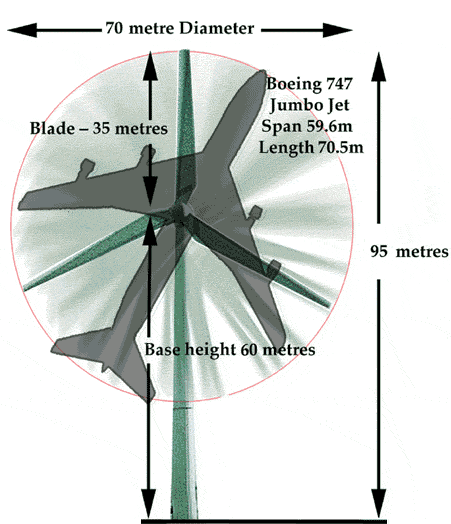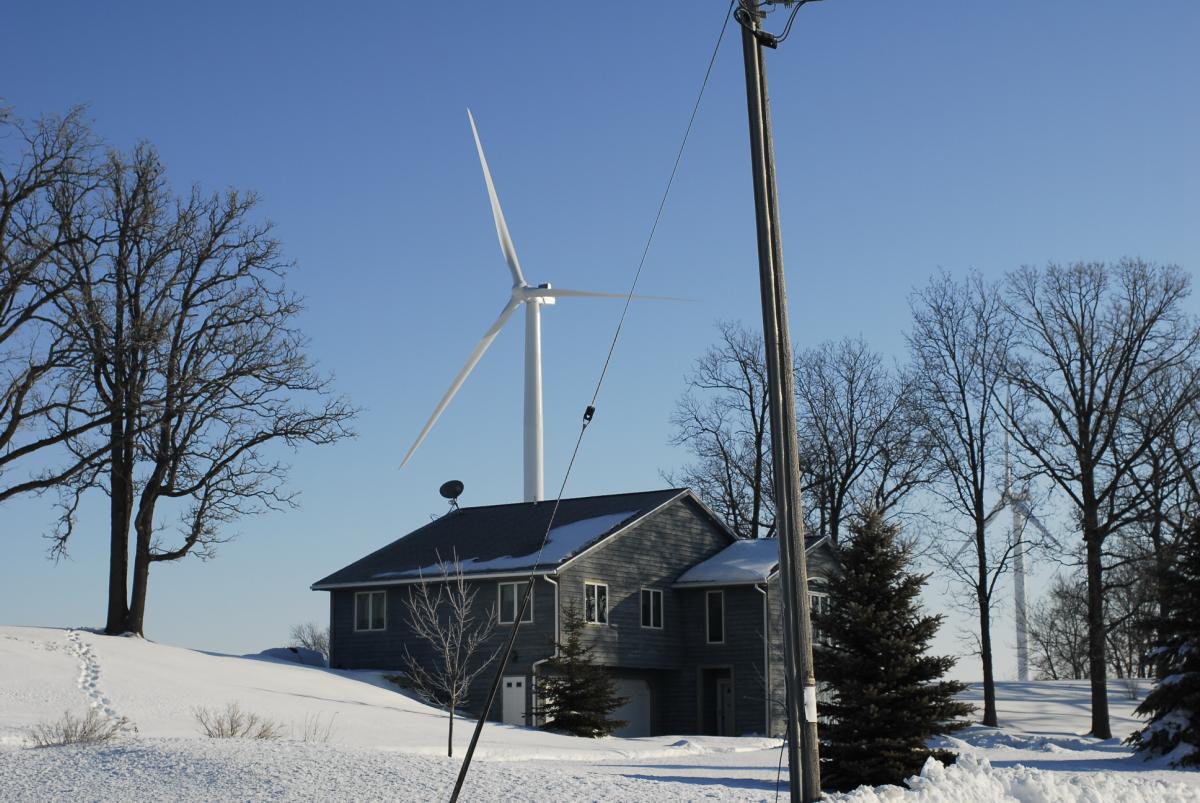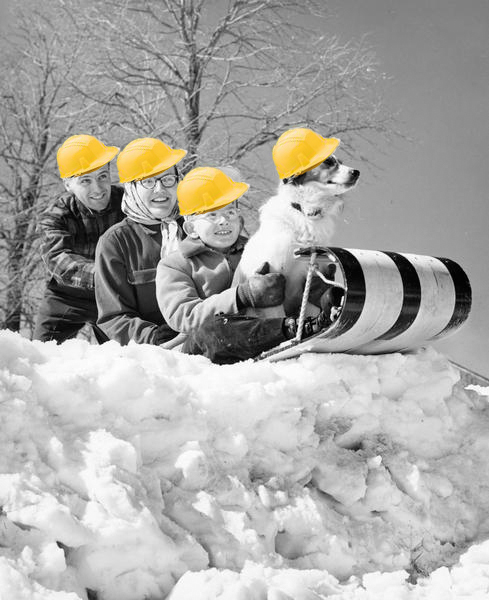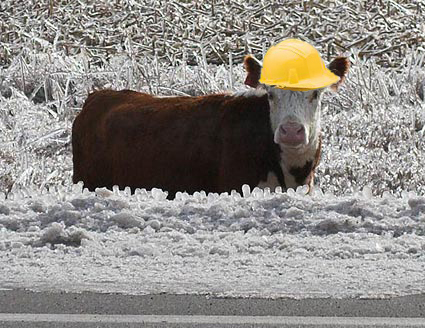12/12/08 PART 3 of our look at the history and content of the Town of Union's Large Wind Ordinance: Today's topic: SETBACKS: How far should a 400 foot tall industrial wind turbine be built from your door? AND Industrial wind turbine setback issues in the news.
B is for Basics
Before we look at what the Town of Union Ordinance has to say about setbacks, let's look at some basic information about industrial wind turbines. The picture below shows a size comparison between a barn, a house, the capitol building in Madison, and the turbine size currently proposed for Rock County. Turbines this size are already in place in Fond du Lac and Dodge Counties where the setback is 1000 feet from homes. In other parts of Wisconsin even larger turbines are proposed.
The rotor diameter of the turbines proposed for Rock County is about 269 feet, with each blade approximately 130 feet long. This blade span is wider than the blade span of a Boeing 747. The newer models are even larger.

The video below shows a model of an industrial turbine to scale, along with photos of wind turbines being erected in Fond du Lac County. The final photo in the video was taken near the town of Byron.
Q: When it comes to siting industrial wind turbines, why do we need a minimum of a 2640 foot setback from our homes?
The following is a summary of the findings about setbacks in the Town of Union wind ordinance. Better Plan, Wisconsin, (BPWI) considers this to be the most thoroughly researched and solid ordinance in the state.
The Town of Union found that large wind turbines are significant sources of noise, which, if improperly sited, can negatively impact the health of residents, particularly in quiet, rural areas. The closer people live to a large wind turbine, the more likely they are to experience problems with the different kinds of noise made by industrial scale turbines.
The closer people live to a large wind turbine, the more likely they are to experience problems with the different kinds of noise made by industrial scale turbines.
There is the noise that comes from the blades passing through the air, which, depending on wind direction, speed, and other factors, can range from a rhythmic whooshing noise to the sound of a jet engine idling on a runway.
There is the mechanical noise that comes from the nacelle, at the hub of the turbine located at the top of the tower where the blade assembly is attached. The nacelle is as large as a school bus and can weigh upwards of 70 tons.
Industrial wind turbines also create low frequency sounds that we feel in our bodies, like the vibration in your chest when a marching band goes by during a parade, or a car with booming speakers stops beside you at a traffic light.
A minimum setback of 2640 feet from a home is necessary to mitigate the noise impacts that aren’t predicted by the one-size-fits-all sound models typically used by wind developers. Noise may be amplified by the lay of the land, atmospheric conditions, time of day, temperature inversions, wind layers and other factors. Low frequency noise can travel much further and easily penetrates the walls of a home.
Distance is the only thing which reliably lessens the negative effects of turbine noise. At 2640 feet, noise from an industrial wind turbine may still be heard from inside your home, but will be less of a problem than the noise from a turbine sited 1000 feet from your home. Residents whose homes are less than 2640 feet from large wind turbines have complained of trouble living with the noise they make, especially at night, and suffer from the variety of health effects associated with loss of sleep.
Recent studies show that a setback of 2640 feet will significantly reduce noise annoyance and associated adverse health effects, but even at that setback people may still suffer from problems associated with turbine noise, especially in quiet, rural environments. A setback of 5280 feet has been shown to eliminate most noise complaints. Both Germany and France have a setback of a mile.
SHADOW FLICKER
This video of shadow flicker was created by a resident of the town of Byron in Fond du Lac county who lives between two turbines. One, less than 1200 feet from his door, casts particularly harsh shadows on his home and property.
When large wind turbines rotate in sunny conditions, they cast enormous moving shadows that cause a disturbing strobe-like flicker where ever they fall.
When the shadow flicker falls on the windows of near-by homes, the effect is like rapidly flipping a light switch on and off. It is an effect that cannot be avoided by occupants of the house unless windows are completely blacked out.
Shadow flicker can cause some people to become dizzy, nauseated, or lose their balance. At certain speeds they pose the potential risk of inducing photosensitive seizures.
Because of this, the Town of Union finds that wind turbine should be sited so that shadows from the blades do not fall upon the windows of nearby dwellings or 100 feet of dwellings for any considerable period.
If placed too close to a road, the movement of the turbine blades resulting in shadow flicker can distract drivers and lead to accidents.
ICE THROW AND BLADE THROW
 Large wind turbines have been known to throw ice and debris from the turbine blades. Ice throws from large wind turbines can reach up to a distance of 1750 feet and blade throws can reach 2500.
Large wind turbines have been known to throw ice and debris from the turbine blades. Ice throws from large wind turbines can reach up to a distance of 1750 feet and blade throws can reach 2500.
WIND TURBINE SETBACK ISSUES IN THE NEWS:
When You're Fed Up With Turbine Noise, Who Do You Call?
(click here for source)
Ocheyeden, IOWA
DECEMBER 11, 2008
Scott Rueter is fed up with the wind turbines that are near his home and with the company that owns them. Rueter, who was scheduled to voice his complaints to the board of supervisors at their last meeting but canceled because of illness, spent about an hour with the board on Tuesday. He said that the noise from the 2.5 megawatt turbines which are located near his home just east of Harris is overwhelming.
According to Rueter, the constant “whoosh, whoosh, whoosh” along with the noise generated by either the generator itself or a fan which operates in the turbine housing are making life on his farm almost unbearable at times.
Additionally, there is the “shadow effect” which is a problem now that the trees have lost their leaves. Rueter says that for several hours a day, the rotation of the blades cast a shadow inside his house as they turn and it’s “almost like a strobe light, just not as fast.”
Rueter stated anyone is welcome to come by his house to see and hear for themselves. He lives one mile east and half mile north of Harris. He said his two kids, ages six and 10, don’t want to go outside to play anymore, because of the noise. Rueter said the noise gets in his head and doesn’t go away when he leaves the area.
The turbines were constructed by Clipper, Inc., but have been sold to Florida Power and Light. The contract that land owners signed with Clipper stated that the turbines would be placed no closer than 1,200 feet to any residence but the closest one to Rueter’s house is actually 1,193 feet away as measured by the Osceola county engineering department with a laser.
Part of the problem is that the turbines are not located on Rueter’s property. They are on a neighbor’s property. The owner lives in Florida and has not responded to Rueter’s request for him to contact FPL.
Rueter has hired an attorney, who has contacted FPL, and got a response that they “were aware of the problem and were concerned” but there has been no other response, even after a second letter was sent by the attorney. Rueter said he has been in the local office of FPL to complain several times, and was told the last time that the company “would get a restraining order against him” if he returned.
He asked that the board of supervisors send a letter to FPL urging them to do something about the problem. He said he didn’t know if it would do any good but felt they might at least be able to get some sort of response.
Rueter said there are four turbines less than a half mile from his house and six that are within one mile (including the one that is less than 1,200 feet away). The Harris man said that Clipper had told land-owners that the turbines “would not make any more noise than a refrigerator”. He said that might be true for the 1.5 megawatt turbines but that the 2.5 megawatt size was much louder.
He also said that FPL is not living up to the contracts they have with landowners. FPL is supposed to shut down the generators whenever ice is building up on surfaces, since the blade tips reach up to 200 MPH in speed, and a chunk of ice thrown from them could do serious damage. Rueter said that Monday night, when ice was accumulating, the turbines were running.
The supervisors indicated that they will probably send a letter to FPL, although at press time no final decision had been made.
NOTE FROM THE BPWI RESEARCH NERD: What is the source of the comparison of the sound of an industrial wind turbine to the sound of a refrigerator? Watch the video below for more clues:
WIND TURBINE SETBACKS IN THE NEWS:
New York Times,
(Click here for source)
Ice-Tossing Turbines: Myth or Hazard?
By Kate GalbraithThey produce clean energy, sure, but they can also hurl a mean snowball.
How do wind turbines fare in winter weather
Not so well, according to one little town in England. The Wisbech Standard reports a harrowing tale in which “lumps of ice three or four feet long flew through the air” and smashed into a carpet showroom and a parking lot.
They apparently came off the spinning blades of a 410-foot-tall wind turbine.
No one was hurt, but residents of Whittlesey, in the southeastern part of England, would not rest until the turbine was shut down. One local businessman described the ice shards as “javelins” coming off the blades.
The wind industry concedes that, as with all tall things (buildings, for example, or trees), ice and snow can build up and, eventually, fall down, creating a hazard to people and structures below.
But the industry denies that “ice-throwing” — another concern surrounding wind power — is a problem. “Ice can end up at places other than exactly at the base of the turbine, but it’s a myth that a turbine will (and can) operate at high speed with ice on it and fling ice for miles,” said Ron Stimmel of the American Wind Energy Association, in an e-mail message.
Just as an airplane will not be able to fly with too much ice on its wings, Mr. Stimmel said, wind turbines are designed to stop or shut off automatically, he said, when they sense the extra weight of ice.
The American Wind Energy Association has posted a brief on the subject, and also discusses the issue in its handbook for siting new wind projects.
But a 2006 publication by G.E. Energy, a maker of large wind turbines, warns that “rotating turbine blades may propel ice fragments some distance from the turbine — up to several hundred meters if conditions are right.”
Its recommendations include placing fences and warning signs around turbines, and locating them a safe distance from buildings or roads. They also recommend deactivating turbines when ice begins to form.
A Swiss report last year, titled “Wind Turbine Ice Throw Studies in the Swiss Alps,” focused on a turbine near a ski area. That report found ice throw to be a “significant safety risk.” The most dangerous place for ice was underneath the turbine, but about 5 percent of fragments landed more than 80 meters — or 260 feet — from the turbine.
A chart from the study shows where and how far ice and snow were flung, relative to the position of the turbine:
 Distribution of ice throw relative to the wind turbine. (Source: Wind Turbine Ice Throw Studies in the Swiss Alps)
Distribution of ice throw relative to the wind turbine. (Source: Wind Turbine Ice Throw Studies in the Swiss Alps)
An earlier German study came to a similar conclusion:
As a general recommendation, it can be stated that wind farm developers should be very careful at ice endangered sites in the planning phase and take ice throw into account as a safety issue. Each incident or accident caused by ice throw is an unnecessary event and will decrease the public acceptance of wind energy.
NOTE FROM THE BPWI RESEARCH NERD: When we look at the following setback recommendations, we cannot help but wonder why the state of Wisconsin continues to insist that 1000 feet is a safe setback. Click here to contact your legislators and ask them if they know about these setbacks, and what they plan to do to insure residents of our state get better protection.
- Manufacturer’s Recommendation: 1,300 feet
- Protection from ice and blade throw: 1750 feet
- U.S. National Research Council: 2,500 feet
- Flicker: 3,300-5,000 feet
- Germany: 1 mile
- France: 1 mile
- Nina Pierpont Study: 1.25 miles
- Kamperman and James Study: 1.2 miles
- Rural Manitoba, Canada: 6,500 feet
- California: 2 miles
- WISCONSIN: 1000 feet
In the upcoming legislative session, there will be a push by certain legislators, supported by the Governor's office, to take the away the power to create ordinances from local governments and hand it all to the Public Service Commission. The Public Service Commission believes 1000 feet is a safe setback.
We don't know if towns with ordinances already in place will be grandfathered in and protected, and we urge local governments to get to work on adopting a wind ordinance that will grant the same protection the residents in the Wisconsin towns of Woodville, Clay Banks, Ridgeville, Wilton, Magnolia and Union now enjoy. Residents in Trempealeau county have even more protection with an ordinance that includes a mile setback.
WHAT CAN YOU DO TO HELP YOUR TOWNSHIP GET TO WORK ON A LARGE WIND ORDINANCE BEFORE IT'S TOO LATE?
YOU CAN CLICK HERE TO CONTACT US!
EVEN MORE ABOUT WIND TURBINE ICE THROW FROM BPWI RESEARCH NERD:
 What is five feet long, three feet wide, five to 6 inches thick, weighs several hundred pounds and can’t be broken by three adults jumping up and down on it?
What is five feet long, three feet wide, five to 6 inches thick, weighs several hundred pounds and can’t be broken by three adults jumping up and down on it?
What roars loudly and sounds scary and makes you instinctually want to stay away?
What did the technical expert say to the turbine salesman?
Wait---is this supposed to be a joke?
Find out by reading this email!
It was sent from John Zimmerman, the president of VERA to some members of the American Wind Energy Association. The AWEA’s stated goal is to promote wind power growth through advocacy, communication, and education.
VERA provides and manages tasks and technical issues considered in commercial scale wind project development. Mr. Zimmerman’s experience is in performing technical due diligence and risk assessment across a variety of technologies.
The following email was written in January of 2000
Subject: Ice Shedding from Turbines and Public Safety
Dear [member names]
I’ve watched over the wind turbines GMP has had installed in Vermont over the last 10 years and I have several thoughts that [may] be useful to this discussion
Here in Vermont, and elsewhere in the northeastern US, the winds blow strongest at the mountain tops, where it is also the most icy. A common first question to wind developers in this region is ‘why don’t you put the wind turbines at the ski areas (where there is human development)’? The answer is because of the danger to public safety due to ice throws. Ski areas are not a good place for wind turbines.
Back in the mid 1980s one of the windy areas that was being considered for wind development was near to ski trails. Boeing and/or Hamilton Standard did some work to determine how far we must stay away from the ski trails to be safe from ice being thrown from their turbines (the MOD 5b was the [B]oeing machine at the time). Without going back to dig up those papers, and if I remember correctly, the distance was between .25 and .5 miles away, down wind. It’s a function of blade tip speed, so applicable to present day turbines too.
While the Boeing study was academic, the danger from ice being release[d] from rotor blades overhead is real—and a hard hat is not going to provide you with much comfort. I have stood near the turbines GMP had on Mt. Equinox in the early 1990’s and more recently the Zond 500 KW turbines in Searsberg VT during and after icing events. When there is heavy rime ice build up on the blades and the machines are running you instinctually want to stay away. They roar loudly and sound scarey. (sic) Probably you would feel safe within the .5 danger zone however.
One time we found a piece of ice near the base of the turbine that was pretty impressive. Three adults jumping on it couldn’t break [it] It looked to be 5 or 6 inches thick, 3 feet wide and about 5 feet long. Probably weighed several hundred pounds. We couldn’t lift it. There were a couple of other pieces nearby but we wondered where the rest of the pieces went.
In the winter, icing is a real danger and GMP therefore restricts public access to the site(s). Maintenance workers have developed protocol for working on turbines during icing conditions, though I am not familiar with the details. I’ll ‘dig into it’ if you want.
Regards,
John Zimmerman,
VERA

Note From the BPRC Research Nerd: For extra credit, read the following comment on the above. It’s from an email written by Randy Swisher, executive director of the AWEA since 1989.
This was written in February of 2004
Dear [name]
Here is a comment from John Zimmerman. He states that wind turbines don’t belong in ski areas, but I think it is really just a question of what is the appropriate setback. John describes some of the ice they have seen at the Searsburg site and it sounds pretty intimidating but manageable with proper setbacks.
I think that is the last of the information I have on the topic. It isn’t a lot but I hope you’ll find it helpful. Please let me know if you need anything else, and feel free to consult our website at www.awea.org as well.
Thanks for your interest. I hope next time I’m riding my bike in the Northeast Kingdom I will actually have a chance to see a few wind turbines!
Randy Swisher
Click here to visit the VERA website
Click here to visit the AWEA website
Click here to visit windaction.org where we found this document
FOR EXTRA EXTRA CREDIT READ ABOUT RIME ICE:
What is it?
Hard rime is a white ice that forms when the water droplets in fog freeze to the outer surfaces of objects. It is often seen on trees atop mountains and ridges in winter, when low-hanging clouds cause freezing fog. This fog freezes to the windward (wind-facing) side of tree branches, buildings, or any other solid objects, usually with high wind velocities and air temperatures between 28°F and 18°F.